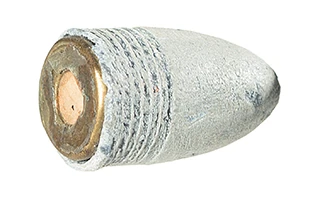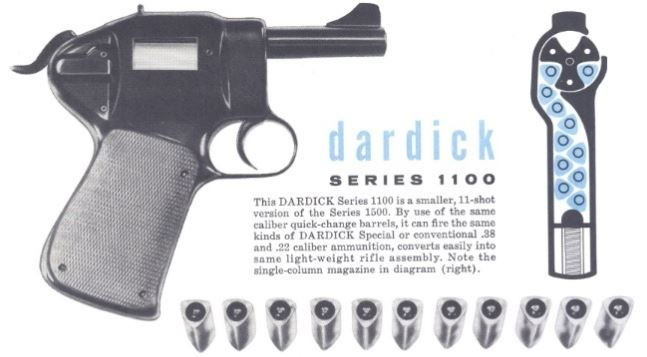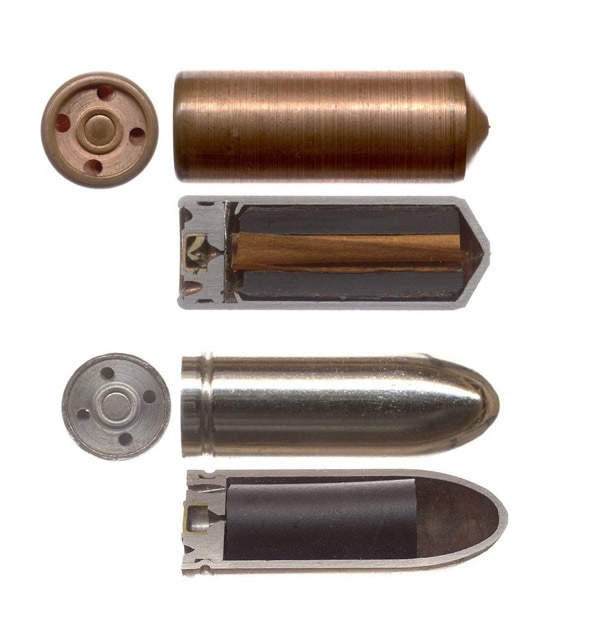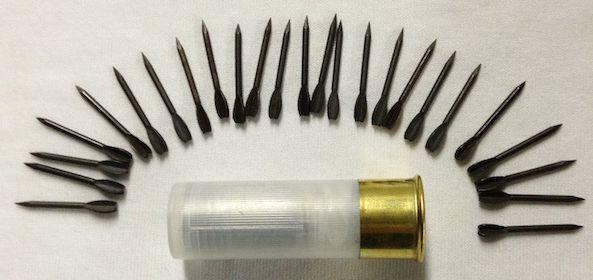What is the next great advancement in firearm technology? We’ve reached a bit of a peak in terms of dedicated firearms. The next frontier is going to be ammo, and we’re seeing that with various concepts like the 6.8x51mm, polymer cases, and caseless ammo as a whole. Here’s the thing: that’s always been the case. We designed the ammo, and the guns follow. Sometimes you get cartridge-based ammo; other times, you just get weird ammo.
Today, we are going to celebrate and enjoy five types of weird ammo through the ages. We have five largely historical ammo types that were never successful but left a fascinating legacy of weirdness in their wake.
The Square Bullet
Bullets in the 1700s were round balls of varying calibers. Muskets and shotguns fired round balls, and that was it. Until James Puckle introduced the Puckle gun. The Puckle gun was a repeating revolver-based weapon designed for ship decks. It fired 25.4mm projectiles with varying capacities up to nine rounds a minute.
Advertisement — Continue Reading Below
The Puckle gun came in two configurations. One fired a round projectile, and that was used for Christians. The alternative fired a square-shaped projectile, which was for Muslims.
The idea was that square bullets would do more damage and cause more pain to the Muslim Turks. James Puckle declared in his patent that square bullets would, “convince the Turks of the benefits of Christian civilization.”
Advertisement — Continue Reading Below
Square bullets aren’t quite aerodynamic, and I don’t think anyone has ever commented on their pain based on bullet shape. Shooting Muslims with different bullets was as bizarre then as it is now. The Puckle gun was not a success and didn’t see any mainstream adoption.
Rocket Ball
Caseless ammo could possibly be the ammo of the future. It’s been tried, most notably with the HK G11, but while it might be the ammo of the future, caseless ammo is also the ammo of the past. Yes, caseless, and it was invented in 1848. They called it the Rocket Ball. The Rocket Ball used a projectile that had its rear hollowed out and loaded with propellant and sealed with a primer in the center.
The Rocket Ball’s purpose was to provide a simpler cartridge for lever-loading firearms. This included early lever-action rifles and pistols. Without a cartridge case, it was light, compact, and simple. Sadly, it was also anemic and had less power than a .25 ACP cartridge.
Advertisement — Continue Reading Below

The Volcanic Arms Company and the Rocket Ball were started by Horace Smith and Daniel Wesson, but eventually sold to Oliver Winchester.
Volcanic Arms and the Rocket Ball went nowhere but gave Winchester a start in the lever-action rifle world. Horace Smith and Daniel Wesson would create S&W, and the rest is history (and so is the Rocket Ball).
Advertisement — Continue Reading Below
Tround
To understand the Tround, you have to understand the platform that fired it. The tround was designed for the Dardick revolver, which was a magazine-fed revolver. The tround was a triangular cartridge case with a traditional bullet. This weird ammo made it possible for the revolving cylinder to pick up rounds from the magazine.
This allowed for reliable feeding but created some very odd and weird ammo. The Dardick tround is most remembered, but the military experimented with trounds for machine guns, but never got it to work. Dardick did, and the system was reliable but unpopular.

Advertisement — Continue Reading Below
New ammo calibers have a hard time getting off the ground, but a new caliber with a new case? Forget about it.
In a fairly smart move, the Dardick company produced adapters to allow a plastic case to fit over normal cartridges, like .38 Special. Still, this couldn’t save the too-cool and atomic-age-looking Dardick revolver.
Gyrojet
We moved from Rocket Ball to Rocket Bullet in a little more than a hundred years. The Gyrojet rounds were a bizarre, rocket-powered ammo that fired from rifles or pistols. The Gyrojet cartridges use rocket motors to propel the projectile. That sounds cool, but I don’t get the point.
Advertisement — Continue Reading Below
The only real benefit I can see is a lack of recoil, at least with the Gyrojets we were presented. A larger system firing 30mm explosive rockets might have been cool, but that wasn’t the case with the Gyrojet pistols and rifles.

In fact, the problem with rocket motors is that they start slowly and gain speed. Initial velocities of this weird ammo were low, and the gun moved slowly. It took about 10 yards for the rocket to reach maximum velocity. That’s not optimum.
The system was tested in Vietnam by special operations, but they didn’t care for it. It did make its way to the James Bond movie You Only Live Twice, so that’s kind of cool. Sadly, the cost and poor performance limited any future development.
Flechettes
Flechettes can work well when loaded into massive bombs or into artillery shells for close-range anti-personnel rounds. That works, but during Vietnam, they decided, “Let’s load these suckers into shotgun shells and 40mm grenades and see what happens.” Flechettes are tiny, fin-stabilized steel darts. Flechette is French for “little arrow.”
When you load them into a shotgun or grenade, they are packed in tight with dozens to hundreds of flechettes. Much like a shotgun, the idea is that they are fired in the direction of the enemy, and they expand away from the center.

Using flechettes was thought to increase the penetration and range of both anti-personnel systems. In real life, they didn’t stabilize from these platforms and flew end over end, testing in the air. This greatly limited their effectiveness and made them fairly useless.
These rounds were quickly removed from the inventory after proving so ineffective. Of all the weird ammo types out there, these flechettes are one of the only ones you can purchase. Why? I don’t know, but you can.
Weird Ammo For Everyone
Sometimes what we consider weird ammo becomes the norm. Spitzer bullets were weird at one time or another. I’m sure plenty of people thought the Minie ball was useless. Sometimes weird ammo is the future; in the five examples above, that’s clearly not the case.
Read the full article here









